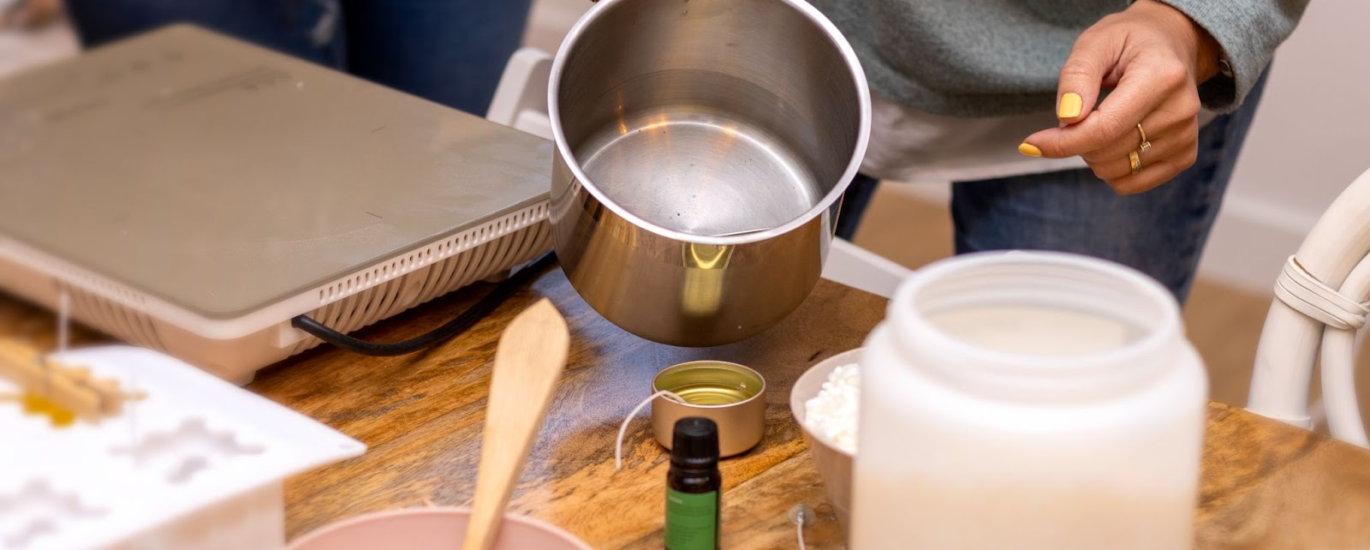Candle making is an art form that has been practiced for centuries, bringing warmth, light, and ambiance to our homes. Whether you’re a professional candle maker or are just starting out, creating your own candles can be a rewarding and fun experience.
And if you’re a beginner and looking to find a few tips and tricks for candle making you’re at the right place! In this guide, we’ll list down ten essential tips and tricks to help you learn the art of candle making.
By incorporating these 10 essential candle-making tips and tricks you can easily start with your candle-making journey!
10 Candle Making Tips And Tricks From A Pro
Listed below are 10 simple candle making tips and tricks that will make you a pro in the art of candle making:
- Don’t panic if you mess up
Mistakes are part of the learning process. If your candle doesn’t turn out as expected, don’t get upset! Take it as an opportunity to learn and improve for next time. Remember, even the most experienced candle makers face mishaps occasionally.
- Clean your container with soapy water before use
Properly cleaning your candle container ensures that there are no dust particles or residues that could affect the quality of your candle. A simple wash with warm, soapy water followed by thorough drying will suffice.
- Track techniques in a candle journal
Maintaining a simple candle journal allows you to record your recipes, techniques, and observations. By doing this, you can track your progress, redo successful batches, and troubleshoot any issues that may arise.
- Ignore the temptation to add extra “stuff” into the mix
While it may be tempting to experiment with various additives like glitter or dried flowers, it’s best to learn the basics first. Focus on perfecting your candle-making technique before incorporating additional elements into your creations.
- Know thy candle wax
Different waxes offer unique characteristics, from soy wax’s clean burn to beeswax’s natural aroma. You should familiarize yourself with the properties of each type of wax to choose the best one for your desired outcome.
- Steer clear of paraffin wax
Paraffin wax, while widely available and inexpensive, is derived from petroleum and can release harmful toxins when burned. Therefore you should choose natural alternatives like soy or other vegetable waxes or beeswax for a cleaner and safer burn.
- Pick the right candle wick
The size and material of your wick can significantly impact the performance of your candle. Choose a wick that is appropriate for the diameter of your container and the type of wax you’re using to ensure an even burn.
- Choose fragrances that jive with your wax
When adding fragrance oils to your candles, select scents that complement the base wax rather than overpowering it. Experiment with different combinations to find the perfect balance for your preferences.
- Pour your fragrance at just the right time
For optimal scent throw, add fragrance oils to your wax when it reaches the correct temperature. Adding them too early or too late can result in a weaker fragrance or even cause the oils to evaporate.
- Give your candle enough time to cure
Allow your candles to cure for at least 24-48 hours before burning them. This resting period allows the wax and fragrance to fully bond, resulting in a stronger scent and better burn performance.
How To Prepare Wax For Candle-Making
Preparing wax for candle-making is a crucial step that sets the stage for the quality and performance of your final product.
- First and foremost, it’s essential to select the right type of wax that aligns with your desired candle characteristics, such as burn time, scent throw, and appearance. Popular options include soy wax, beeswax, paraffin wax, and coconut wax.
- Once you’ve chosen your wax, accurately measure the required amount using a kitchen scale. It’s crucial to measure by weight rather than volume for precision. Next, melt the wax using a double boiler or dedicated wax melting pot, ensuring even heating and avoiding direct heat sources that can degrade the wax.
- Now, if you wish to add fragrance or color to your candles, incorporate fragrance oils or dye chips into the melted wax at the appropriate temperature. Stir the mixture thoroughly to ensure uniform distribution of additives.
- Before pouring the wax into your candle containers, prepare them by securing wicks in the center using adhesive or wick stickers. Make sure that the wicks are straight and centered to promote an even burn.
- Once the wax is melted and extra additives are incorporated, carefully pour it into the prepared containers, leaving a small amount of space at the top. Allow the candle ingredients to cool and solidify completely before handling or moving them, typically taking several hours.
By following these steps to prepare your wax for candle-making, you’ll lay the groundwork for creating beautiful, high-quality candles.
Why Choose Lova Candle Pearls™?
Creating your own set of candles is surely fun. However, when it comes to investing in high-quality candles, there’s nothing quite like Lova Candle Pearls™. We offer trendy self-melting pearled wax crafted from premium,100% plant-based wax. You do not need to melt the wax, simply pour it in the appropriate vessel, insert the wick (included) and light up! Pearled Candles do not soot, smoke, drip or stick to the vessels if used correctly. It’s a top choice for the florist, decorator and health and environmentally conscious people. With Lova Candle Pearls™ you will get a new candle every time you burn it with a minimal effort or waste, making it a more economical option as well.
Conclusion
To conclude, candle making is a perfect blend of artistry and science that will allow you to make beautiful and personalized candles for yourself and your loved ones. Remember, practice makes perfect, so don’t be discouraged by any initial setbacks. With the tips and tricks provided in this guide, you’re well-equipped to begin with your candle-making journey.
FAQ
- What supplies do I need to make candles?
Basic supplies include wax, wicks, containers, fragrance oils, a double boiler, thermometer, and stirring utensils. Optional additives include dyes, additives, and molds.
- How do you make the perfect candle ingredients?
The perfect candle involves choosing the right wax, wick, fragrance, and container size while following proper pouring and curing techniques.
- What not to do when making candles?
Avoid using excessive fragrance oils, neglecting proper temperature control, and using unsuitable containers or wicks.
- How can I make my candles better?
Continuously educate yourself, experiment with different techniques and materials, keep detailed records, and pay attention to customer feedback to improve your candle-making skills. And try Lova Candle Pearls™ to be in trend!






